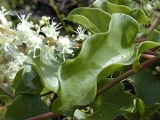
Anredera cordifolia
Encyclopedia
Anredera cordifolia, commonly known as the Madeira vine or mignonette vine, is a South American species
of ornamental
succulent vine of the family Basellaceae
. The combination of fleshy leaves and thick aerial tubers makes this a very heavy vine. It smothers trees and other vegetation it grows on and can easily can break branches and bring down entire trees on its own.
A. cordifolia is an evergreen
climber that grow from fleshy rhizome
s. It has bright green, heart-shaped, fleshy shiny leaves 4–13 cm long. Wart-like tubers are produced on aerial stems and are a key to identifying the plant. It produces masses of small fragrant, cream flowers on dependent racemes, which may be up to 30 cm (12 in) in length. The plant spreads via the tubers, which detach very easily.
A. cordifolia can reproduce through the proliferation of tubers and also from rhizome fragments that may be broken off. Although this species has both male and female flowers they rarely reproduce sexually and produce seed
. This species often spreads through its own vegetative growth, but can easily be transported by human activities. If fragments end up in waterways, they are easily transported to new locations in this manner.
It has been introduced to Africa, Australasia-Pacific region, Europe, and North America; it is considered an invasive species in many tropical and sub-tropical localities. It is listed on the New Zealand National Pest Plant Accord
which limits its cultivation and sale.
Species
In biology, a species is one of the basic units of biological classification and a taxonomic rank. A species is often defined as a group of organisms capable of interbreeding and producing fertile offspring. While in many cases this definition is adequate, more precise or differing measures are...
of ornamental
Ornamental plant
Ornamental plants are plants that are grown for decorative purposes in gardens and landscape design projects, as house plants, for cut flowers and specimen display...
succulent vine of the family Basellaceae
Basellaceae
Basellaceae is a family of flowering plants, in the order Caryophyllales in the clade core eudicots, according to the Angiosperm Phylogeny Group...
. The combination of fleshy leaves and thick aerial tubers makes this a very heavy vine. It smothers trees and other vegetation it grows on and can easily can break branches and bring down entire trees on its own.
A. cordifolia is an evergreen
Evergreen
In botany, an evergreen plant is a plant that has leaves in all seasons. This contrasts with deciduous plants, which completely lose their foliage during the winter or dry season.There are many different kinds of evergreen plants, both trees and shrubs...
climber that grow from fleshy rhizome
Rhizome
In botany and dendrology, a rhizome is a characteristically horizontal stem of a plant that is usually found underground, often sending out roots and shoots from its nodes...
s. It has bright green, heart-shaped, fleshy shiny leaves 4–13 cm long. Wart-like tubers are produced on aerial stems and are a key to identifying the plant. It produces masses of small fragrant, cream flowers on dependent racemes, which may be up to 30 cm (12 in) in length. The plant spreads via the tubers, which detach very easily.
A. cordifolia can reproduce through the proliferation of tubers and also from rhizome fragments that may be broken off. Although this species has both male and female flowers they rarely reproduce sexually and produce seed
Seed
A seed is a small embryonic plant enclosed in a covering called the seed coat, usually with some stored food. It is the product of the ripened ovule of gymnosperm and angiosperm plants which occurs after fertilization and some growth within the mother plant...
. This species often spreads through its own vegetative growth, but can easily be transported by human activities. If fragments end up in waterways, they are easily transported to new locations in this manner.
It has been introduced to Africa, Australasia-Pacific region, Europe, and North America; it is considered an invasive species in many tropical and sub-tropical localities. It is listed on the New Zealand National Pest Plant Accord
National Pest Plant Accord
The National Pest Plant Accord identifies pest plants that are prohibited from sale and commercial propagation and distribution across New Zealand....
which limits its cultivation and sale.
Further reading
- Invasive Species Specialist Group (ISSG). Anredera cordifolia

